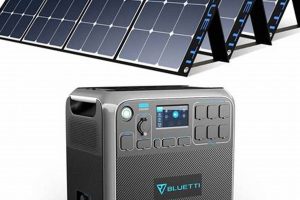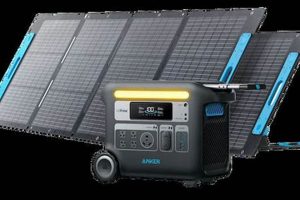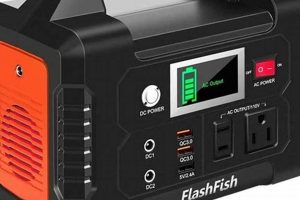Compact, self-contained power stations utilizing photovoltaic panels to generate and store electricity offer off-grid power solutions. These systems typically integrate a battery, charge controller, and various output ports (AC, DC, USB) within a single, easily transportable unit. A common application involves powering devices like smartphones, laptops, and small appliances during camping trips, power outages, or in locations lacking conventional electricity access.
The ability to generate renewable energy on demand reduces reliance on fossil fuels and lowers environmental impact. This independence from the power grid provides critical backup power during emergencies and enhances resilience in the face of natural disasters or grid instability. The development and increasing affordability of these systems have broadened access to reliable power for remote work, recreational activities, and disaster preparedness.
Further exploration will cover specific features to consider when selecting a system, including battery capacity, power output, panel efficiency, and overall portability. Additional topics will address practical applications, maintenance requirements, and the evolving role of these devices in a world increasingly focused on sustainable energy solutions.
Tips for Utilizing Compact Solar Generators
Maximizing the effectiveness and lifespan of a compact solar generator involves understanding its capabilities and employing best practices. The following tips offer guidance for optimal use.
Tip 1: Understand Power Needs: Accurately assess power requirements of devices intended for connection. Calculate total wattage and anticipated usage duration to select a system with adequate capacity.
Tip 2: Optimize Solar Charging: Position solar panels for maximum sunlight exposure throughout the day. Adjust panel angle periodically to follow the sun’s path for optimal energy capture.
Tip 3: Prioritize Energy Consumption: Power essential devices first and limit non-essential usage to conserve battery power. Monitor power levels regularly to avoid unexpected depletion.
Tip 4: Proper Battery Maintenance: Adhere to manufacturer recommendations for battery charging and storage. Avoid completely depleting the battery and store the unit in a cool, dry location when not in use.
Tip 5: Regular System Checks: Periodically inspect cables, connections, and the overall unit for signs of wear or damage. Address any issues promptly to maintain optimal performance and safety.
Tip 6: Explore Supplemental Charging: Consider alternative charging methods, such as AC wall outlets or car chargers, to replenish the battery when solar charging is unavailable or insufficient.
Tip 7: Plan for Weather Conditions: Monitor weather forecasts and adjust usage accordingly. Consider carrying extra battery packs or reducing energy consumption during periods of limited sunlight.
By following these guidelines, users can ensure reliable power availability, extend the lifespan of their units, and maximize the benefits of off-grid power solutions.
Equipped with this practical knowledge, the concluding section offers a final perspective on the value and future potential of these versatile power systems.
1. Portability
Portability represents a defining characteristic of these power solutions, enabling convenient transport and deployment in various scenarios. Compact designs and lightweight materials facilitate easy carrying, while integrated handles or wheels further enhance mobility. This portability unlocks access to power in off-grid locations, supporting activities such as camping, hiking, and remote work. Furthermore, rapid deployment during power outages or emergencies provides critical backup power for essential devices and appliances. For instance, during a natural disaster, a portable unit can power communication devices, medical equipment, or lighting, bridging the gap until grid power is restored. This capability enhances individual and community resilience in the face of unexpected disruptions.
The practical significance of portability extends beyond recreational use and emergency preparedness. In remote areas lacking reliable grid infrastructure, these systems offer a sustainable power source for essential services. Medical clinics, schools, and small businesses can operate independently, fostering economic development and improving quality of life. Furthermore, portability empowers individuals engaged in mobile work or van life, providing reliable power for laptops, tools, and other equipment. This adaptability supports a flexible and increasingly mobile workforce.
In conclusion, portability is not merely a convenient feature but a fundamental attribute that expands the reach and impact of these power systems. By enabling access to power in diverse contexts, from recreational pursuits to essential services, portability enhances resilience, promotes sustainability, and empowers individuals and communities. Addressing challenges related to weight, size, and durability will further optimize portability and unlock the full potential of these versatile power solutions.
2. Solar Charging
Solar charging forms the foundation of portable Goal Zero solar generators, enabling sustainable and independent power generation. Harnessing photovoltaic technology, these systems convert sunlight directly into electricity, stored within an integrated battery for later use. Understanding the nuances of solar charging is crucial for maximizing system performance and realizing the full potential of off-grid power solutions.
- Panel Efficiency and Output:
Panel efficiency directly impacts the rate of solar energy conversion. Higher efficiency panels generate more power in less time, especially beneficial in areas with limited sunlight. Output is measured in watts and determines the charging speed of the generator’s battery. Selecting panels with appropriate efficiency and output is essential for meeting specific power demands. For example, a higher wattage panel will charge a laptop faster than a lower wattage panel, enabling quicker access to essential tools.
- Sunlight Exposure and Panel Positioning:
Optimal sunlight exposure is paramount for effective solar charging. Positioning panels perpendicular to the sun’s rays maximizes energy capture. Regular adjustments throughout the day are often necessary to follow the sun’s path and maintain optimal charging efficiency. Factors such as shading, cloud cover, and time of year influence the amount of sunlight available, impacting overall charging performance. For instance, during winter months, shorter daylight hours and lower sun angles necessitate more careful panel placement to maximize limited sunlight availability.
- Charge Controllers and Battery Management:
Charge controllers regulate the flow of energy from the solar panels to the battery, preventing overcharging and optimizing battery lifespan. These controllers protect the battery from damage and ensure safe and efficient charging. Advanced charge controllers may offer features like maximum power point tracking (MPPT) to further optimize energy harvesting from the solar panels. Effective battery management, including proper charging cycles and storage practices, is essential for long-term battery health and overall system performance. Consistent adherence to recommended practices ensures reliable power availability when needed.
- Environmental Factors and Charging Performance:
Environmental factors significantly influence solar charging performance. Temperature, altitude, and atmospheric conditions can affect panel efficiency and overall energy output. Understanding these factors and their potential impact allows users to adjust expectations and implement strategies to mitigate limitations. For example, higher altitudes can experience increased solar radiation, potentially boosting charging performance, while extreme temperatures can negatively affect panel efficiency. Accounting for these variables ensures realistic expectations and informed decision-making regarding power usage and supplemental charging options.
By understanding these facets of solar charging, users can optimize system performance, maximize energy harvesting, and ensure reliable power availability. This knowledge empowers informed decisions regarding panel selection, system maintenance, and usage strategies, ultimately maximizing the benefits of portable Goal Zero solar generators as sustainable and resilient power solutions. Further exploration could compare different solar panel technologies and delve into advanced charging techniques to further enhance understanding and optimize performance in diverse environments.
3. Independent Power
Independent power, a defining characteristic of portable Goal Zero solar generators, signifies freedom from reliance on traditional power grids. This independence stems from the system’s ability to generate and store its own electricity, primarily through solar panels. The practical significance of this autonomy becomes readily apparent in scenarios where grid power is unavailable or unreliable, such as during camping trips, power outages caused by natural disasters, or in remote locations lacking grid infrastructure. Consider a scenario where a family relies on a portable solar generator during a prolonged power outage. The ability to power essential appliances like refrigerators, lights, and communication devices provides a critical lifeline, enhancing safety and comfort during an otherwise challenging situation. Similarly, in off-grid locations, these generators empower individuals and communities by providing access to electricity for essential services, fostering economic development, and improving quality of life.
Furthermore, independent power facilitates greater flexibility and self-reliance. Individuals engaged in mobile work, such as fieldwork or disaster relief, benefit from the ability to power their equipment without needing external power sources. This adaptability extends to recreational activities like camping and overlanding, where portable solar generators provide power for lighting, cooking, and electronic devices, enhancing the overall experience and enabling access to remote locations. The practical applications extend beyond individual use. Small businesses operating in areas with unreliable grid power can maintain essential operations, minimizing disruptions and ensuring business continuity. For example, a mobile food vendor can power refrigeration units and cooking equipment, regardless of grid availability, expanding their reach and customer base.
In conclusion, independent power, as embodied by portable Goal Zero solar generators, represents a significant shift in how we access and utilize electricity. This independence enhances resilience in the face of emergencies, empowers individuals and communities in off-grid locations, and supports a more flexible and mobile workforce. While challenges remain in terms of optimizing energy storage capacity and improving panel efficiency, the growing adoption of these systems underscores their value in a world increasingly focused on sustainable and decentralized power solutions. The continued development and refinement of these technologies promise to further expand access to reliable and independent power, shaping a future where energy independence is within reach for all.
4. Goal Zero Integration
Goal Zero integration represents a crucial aspect of portable Goal Zero solar generators, signifying more than just branding. It denotes a cohesive ecosystem of compatible components, accessories, and software designed to optimize system performance, user experience, and overall functionality. This integration encompasses various elements, from the seamless compatibility between solar panels, batteries, and power stations to the sophisticated power management systems that optimize charging and discharging processes. The practical significance of this integration lies in its ability to streamline user interaction, maximize energy efficiency, and provide a comprehensive solution for off-grid power needs. For instance, Goal Zero’s Yeti power stations are designed to work seamlessly with their Boulder solar panels and Link module, ensuring optimal charging performance and simplified setup. This integration eliminates compatibility concerns and allows users to focus on utilizing the power rather than troubleshooting technical issues.
Furthermore, Goal Zero integration extends to software applications and monitoring tools. The Goal Zero Yeti App, for example, provides real-time insights into battery levels, power usage, and solar charging performance. This level of monitoring empowers users to make informed decisions about energy consumption and optimize system usage based on real-time data. This interconnectedness fosters a deeper understanding of energy usage patterns and promotes more efficient power management. In practical applications, this integration translates to a more user-friendly experience, particularly for those new to solar power. The simplified setup, intuitive controls, and comprehensive monitoring capabilities reduce the learning curve and enable users to quickly harness the benefits of off-grid power. Moreover, the compatibility between various Goal Zero components allows for system expansion and customization based on evolving needs. Users can easily add additional solar panels, battery modules, or accessories as their power requirements change, ensuring long-term scalability and adaptability.
In conclusion, Goal Zero integration represents a core strength of portable Goal Zero solar generators, distinguishing them from generic solar power systems. This integration fosters seamless compatibility, optimized performance, and enhanced user experience. While challenges remain in terms of further refining software integration and expanding compatibility with third-party devices, the current ecosystem provides a robust and user-friendly platform for harnessing the power of solar energy. The continued development and expansion of this integrated approach promise to further solidify Goal Zero’s position as a leader in portable power solutions, driving innovation and accessibility in the off-grid power market.
5. Sustainable Energy
Sustainable energy represents a critical focus in the context of portable Goal Zero solar generators, signifying a shift away from reliance on fossil fuels towards renewable resources. These generators embody this principle by harnessing solar energy, a clean and abundant resource, to generate electricity. This transition aligns with broader efforts to mitigate climate change and promote environmentally responsible energy consumption. The following facets explore the multifaceted connection between sustainable energy and portable Goal Zero solar generators.
- Reduced Carbon Footprint
Portable Goal Zero solar generators significantly reduce reliance on fossil fuel-powered generators, which emit greenhouse gases contributing to climate change. Utilizing solar energy minimizes carbon emissions, promoting a cleaner energy profile and supporting environmental sustainability. Replacing a gasoline-powered generator with a solar-powered alternative during camping trips, for instance, directly reduces an individual’s environmental impact. This shift contributes to broader efforts to mitigate climate change and transition towards a low-carbon future.
- Decentralized Power Generation
Unlike centralized power grids reliant on large-scale power plants, portable solar generators promote decentralized power generation. This distribution of power sources enhances resilience in the face of grid disruptions and empowers individuals and communities to generate their own electricity. In disaster relief scenarios, for example, portable solar generators can provide essential power in affected areas, independent of damaged grid infrastructure. This decentralized approach fosters greater energy independence and enhances community resilience.
- Renewable Resource Utilization
Solar energy, the primary source for portable Goal Zero solar generators, represents a renewable resource, unlike finite fossil fuels. This reliance on a continuously replenished energy source ensures long-term sustainability and reduces dependence on depleting resources. Harnessing solar energy promotes a circular economy approach to energy generation, minimizing environmental strain and promoting resource conservation. This approach contributes to a more sustainable energy landscape for future generations.
- Conservation and Efficiency
Portable solar generators often encourage conscious energy consumption due to their finite battery capacity. This awareness promotes energy conservation practices and encourages users to prioritize essential power needs. This mindful approach to energy use aligns with broader sustainability goals of reducing overall energy demand and maximizing efficiency. For example, users may prioritize powering essential communication devices and lighting while minimizing non-essential power usage during off-grid excursions. This mindful approach contributes to overall energy conservation efforts.
In conclusion, portable Goal Zero solar generators represent a tangible embodiment of sustainable energy principles. By harnessing renewable resources, reducing carbon footprints, and promoting decentralized power generation, these systems contribute to a more sustainable energy future. While challenges remain in terms of optimizing energy storage and improving panel efficiency, the increasing adoption of these generators signifies a growing commitment to sustainable energy solutions. Continued innovation and development in this field will further enhance the role of portable solar generators in powering a cleaner and more resilient future.
Frequently Asked Questions
This section addresses common inquiries regarding portable Goal Zero solar generators, providing concise and informative responses.
Question 1: What is the typical lifespan of a portable Goal Zero solar generator’s battery?
Battery lifespan varies depending on usage patterns and maintenance. Most Goal Zero batteries are designed for hundreds of charge cycles, typically lasting several years with proper care. Adhering to manufacturer recommendations regarding charging and storage practices can significantly extend battery longevity.
Question 2: Can these generators power household appliances during a power outage?
Capacity dictates the types of appliances that can be powered. Smaller generators are suitable for charging electronic devices and powering small appliances. Larger units with higher wattage outputs can power larger appliances like refrigerators or power tools, though runtime will vary based on appliance power consumption.
Question 3: How long does it take to fully recharge a portable Goal Zero solar generator using solar panels?
Recharge time depends on factors such as solar panel wattage, sunlight availability, and battery capacity. Under ideal sunlight conditions, smaller generators may recharge within a few hours, while larger units might require a full day of sunlight. Supplemental charging options like AC wall outlets or car chargers can expedite the process.
Question 4: Are portable Goal Zero solar generators weatherproof?
Weather resistance varies across models. Some units are designed to withstand light rain or splashes, while others offer greater protection against the elements. Consulting product specifications is crucial for determining the specific level of weather resistance. Protecting the unit from extreme weather conditions is always recommended to ensure optimal performance and longevity.
Question 5: What maintenance is required for a portable Goal Zero solar generator?
Regular maintenance is minimal but crucial. Periodically inspecting cables, connections, and the overall unit for signs of wear or damage is essential. Following manufacturer guidelines for battery maintenance, including proper charging and storage practices, is also crucial for maximizing battery lifespan and overall system performance.
Question 6: What are the key factors to consider when selecting a portable Goal Zero solar generator?
Key considerations include power output, battery capacity, portability, solar panel compatibility, and intended usage scenarios. Carefully assessing power needs and usage patterns will guide selection of a system with appropriate specifications. Researching specific features, such as integrated inverters, output ports, and charging options, further refines decision-making based on individual requirements.
Understanding these aspects facilitates informed decision-making, ensuring selection of a system that aligns with individual needs and usage patterns. Thorough research and consideration of specific features will maximize the benefits of these versatile power solutions.
Further exploration could involve comparing different Goal Zero models and delving deeper into specific technical specifications to assist potential users in selecting the optimal system for their unique requirements.
Portable Goal Zero Solar Generators
Portable Goal Zero solar generators offer a compelling solution for diverse power needs, from recreational activities to emergency preparedness. Their integration of portability, solar charging capabilities, and Goal Zero’s system design provides a versatile and reliable power source independent of traditional grids. Key aspects explored include the significance of portability for off-grid access, the intricacies of solar charging optimization, the advantages of independent power generation, the seamless integration within the Goal Zero ecosystem, and the overarching commitment to sustainable energy principles. Understanding these facets empowers informed decision-making regarding system selection, usage, and maintenance, maximizing the benefits of this innovative technology.
As reliance on sustainable and resilient power solutions intensifies, portable Goal Zero solar generators represent a significant step towards a future where clean energy access is readily available. Continued advancements in battery technology, solar panel efficiency, and system integration promise further enhancements in performance, portability, and affordability. Exploration of these evolving capabilities and their potential impact on individual, community, and global energy landscapes warrants continued attention and investment. Embracing these technologies empowers a transition towards a more sustainable and energy-independent future, fostering resilience and reducing reliance on traditional, environmentally impactful power sources.






